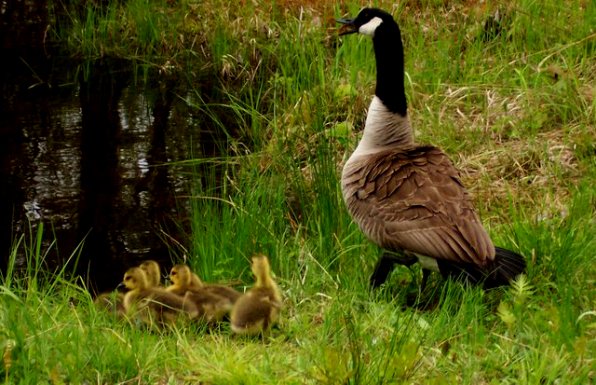In early spring, when I was in a large flock of Canada geese getting ready to leave our winter playground on the Chesapeake Bay of Maryland, I noticed the handsome gander that soon became my mate. We stayed together all during our journey north as our flock traveled in the famous V-shaped formation, honking all the way. I am sure we must have sounded like a pack of baying hounds. We stopped in fields and ponds to rest. My gander and I had our honeymoon on the shore of a remote pond in Connecticut.
Our flock stopped to rest on a pond near Concord, New Hampshire. When the gang was getting ready to leave, my gander and I intuitively knew this was where we would settle down. It was so very quiet after the noisy flock took to the air and disappeared over the tree tops. We found the perfect place for our nest, on the side of a beaver lodge in the middle of the pond.
For seven days, I laid an egg a day and then started to incubate the eggs so they would all hatch at the same time. For 28 days I sat on the eggs, turning them occasionally and keeping them warm, especially on cold nights. I would leave the nest briefly each morning and evening while my faithful gander was on guard.
Early in May, I started to hear the peeping sounds of my goslings as they broke out of their shells. What an active bunch they were! Within 24 hours, we were all out on the water, and my gander had joined us. Our goslings were able to swim, pe and feed themselves immediately. I enjoyed watching them eat tender water plants and small insects. All the while, they were carefree and oblivious to the many perils that lurked in the shadows.
On our third day together, we lost one of our goslings to a snapping turtle. Goslings are prime targets not only for snapping turtles, but also for hawks, owls, foxes, snakes and bobcats. My gander and I are constantly on the alert for danger. At the approach of a threatening creature, I will hiss and make a big fuss by wildly flapping my wings. My aggressive noise and displays are enough to turn away most intruding predators.
Our six goslings are now two weeks old. In another two weeks they will start losing their natal down and begin growing feathers. In about two months they will be able to fly, and we will stay together all summer. It is hard to believe that by this fall, if all goes well, my fledgling offspring will be flying with me back to our winter playground on the Chesapeake. That is the joy of being a Mother Goose.
A note from Paul Basham:
I hope Mother Goose and her family will find the southbound flyway in the sky before the start of this fall's open season on Canada geese, which according to Steven Weber, chief of the New Hampshire Fish and Game Wildlife Division, will no doubt be in early September, just like last fall.









